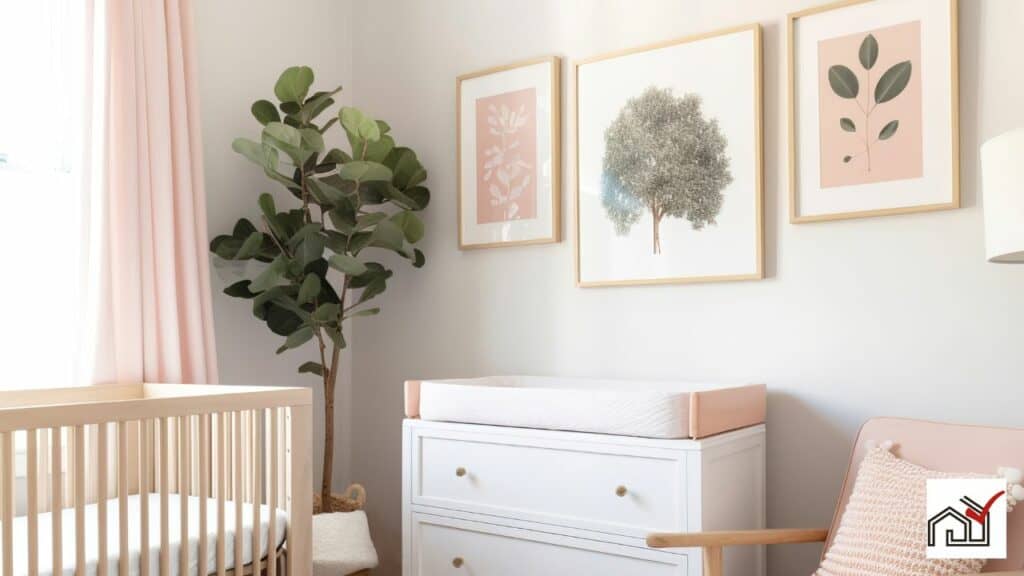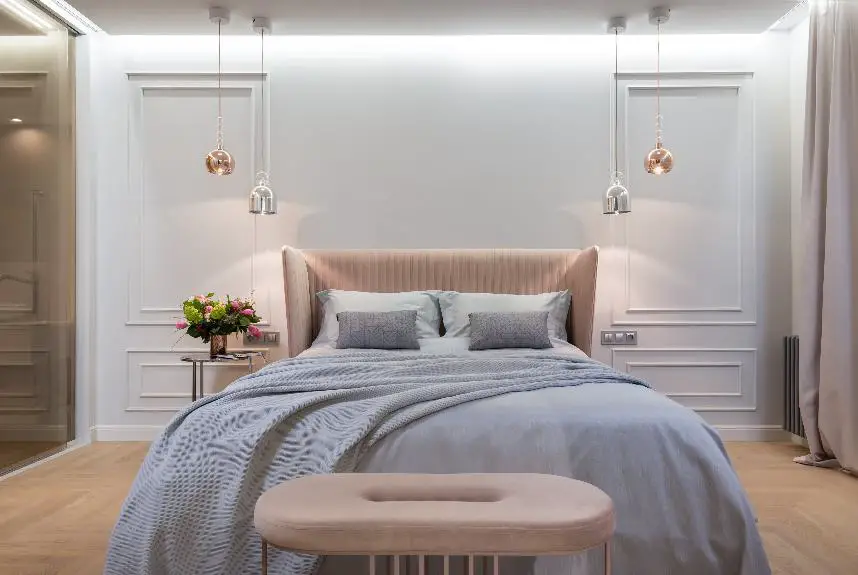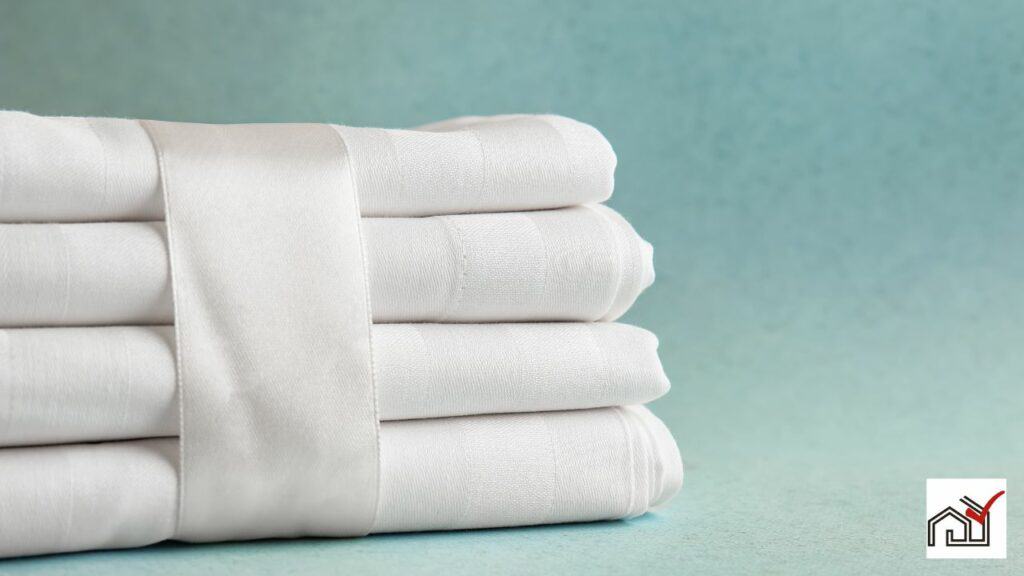When selecting curtains for a nursery, consider both their look and function. Safety is a top priority; choose curtains free from hazards like long cords to prevent accidents.
The material should allow for light control to encourage sleep, with adjustable opacity being ideal. Easy-to-clean fabrics are practical for maintenance.
The curtains' color and pattern should also match the nursery's theme.
By addressing these points, you can create a safe and visually appealing nursery.
Assessing Light Control Needs
When choosing nursery curtains, it's important to consider how much light to block out to help the baby sleep well. Blackout curtains are effective for this purpose as they block sunlight and keep the room dark during naps.
These curtains also help regulate room temperature, keeping it stable and comfortable, especially in rooms facing east or south that get a lot of light.
Some parents may prefer blackout shades or roman shades for a cleaner look while still controlling light. If there are already blinds in the nursery, a curtain liner can be added to reduce light further. This setup allows parents to adjust the amount of light during playtime and provide darkness for sleep.
Safety is essential when installing light control solutions. They must be securely installed and free from cords or potential hazards for toddlers. Proper light control contributes to a peaceful and secure environment for the baby.
Understanding Fabric Options
After evaluating the need for light control, it's important to explore the different fabric choices for nursery curtains. These choices impact the room in terms of safety, maintenance, and visual appeal.
Cotton is a preferred material because it reduces dust and sunlight, making it a smart option for a nursery. It's also durable and easy to clean.
Silk adds an elegant touch without being impractical for a child's room. It can enhance the nursery's design with its soft glow and rich texture, while still being functional.
Choosing the right fabric is not just about aesthetics; it affects the safety and comfort of the baby. The materials should be robust enough for regular washing and safe for the child. It's necessary to find a balance between the look and the practicality of the curtains to create a secure and cohesive space.
Selecting the Right Color Scheme
When choosing curtains for a nursery, it's important to consider the existing decor to create a pleasant and sleep-friendly environment. The color of the curtains should complement the room's color scheme. Aim for a balance between visual stimulation and calmness, selecting soothing yet engaging colors.
Dark-colored curtains can block out light, aiding the baby's sleep. If the nursery has a blackout lining, there's more flexibility in color choice, allowing for lighter or pastel colors that still prevent light from disturbing sleep.
The room's atmosphere is affected by color choice. Soft blues and greens have a calming effect, suitable for a nursery. Warmer colors can add cheerfulness.
Curtains should match other elements in the room, like bedding and wall art, for a unified look. Adding prints, such as teddy bears or flowers, should be done tastefully to maintain a balance.
The objective is to choose curtains that are both practical and aesthetically pleasing in the nursery.
Prioritizing Safety Features
When choosing curtains for a nursery, safety is the top priority to protect infants and young children. Select curtains with safety features that meet National Safety standards to avoid strangulation hazards. Curtains should be short to prevent children from pulling or climbing on them, which could result in falls or entanglement.
Install curtain rods securely to the wall to prevent them from being pulled down. Tension rods are not recommended as they may collapse if pulled, creating a danger. Use sturdy hardware that can endure children's activities.
Choose curtains without beads or loose threads to eliminate choking hazards. Simple designs are safer and can still be attractive. Consider blinds or shades as alternatives, but ensure they have no accessible cords to prevent strangulation risks.
Considering Curtain Length
Selecting the appropriate curtain length for a nursery involves considering both style and function. Hang the curtains high, near the ceiling, to make the windows appear taller. Choose a length that just touches the floor for a neat look. For a more decorative effect, the curtains can extend 3-4 inches onto the floor. To determine the proper length, measure from the top of the window down to the floor, subtracting a few inches for the curtain hardware. If necessary, tailor the curtains to fit. It's preferable to buy longer curtains and hem them rather than choose ones that are too short. For small windows or when the area beneath the window is in use, shorter curtains that reach the sill may be more suitable. Combining aesthetic with practicality, the correct curtain length will help create a comfortable nursery environment.
Coordinating With Nursery Decor
Curtain length is important, and it's also crucial to choose designs that match the nursery decor for a cohesive look. The curtains should block light, ensure privacy, and add to the room's style.
Match the curtains to the nursery's color scheme or theme, whether it's pastels, bright colors, or neutrals. Patterns with stars, animals, or child-friendly designs can be a playful addition.
Use tie-backs or valances that fit the nursery's theme, such as nautical, fairytale, or jungle, to complete the look. Curtains should also go well with other items in the room, like rugs, bedding, and wall decor. This creates a consistent and welcoming space.
Choose curtains made from safe, durable materials that are appropriate for children, ensuring they are both functional and a good fit for the nursery decor.
Evaluating Maintenance and Cleanliness
When choosing nursery curtains, prioritize easy maintenance and cleanliness to maintain a hygienic environment for your child. Cotton curtains are a practical option because they are easy to wash and resist dust accumulation. Alternatively, blinds or shades are easy to wipe down and less likely to collect dust and allergens, simplifying the cleaning process.
Blackout curtains are beneficial for both blocking light and being easy to care for, making them suitable for a child-friendly nursery. Double-layered curtains provide flexibility in light control and insulation, and they can be cleaned separately.
Installing With Care and Precision
Choose nursery curtains that are safe and easy to clean. Install them securely to protect your child. Correct installation is important for safety. Find wall studs to attach curtain hardware. If there are no studs, use strong drywall anchors to support the curtain weight. This prevents the curtains from falling as your child grows.
Be careful with tension rods as they can fall if pulled, which can be dangerous. Permanent fixtures are safer for an active toddler.
Install the curtains by following the instructions on the hardware packaging. This will help you avoid mistakes and ensure the hardware is installed correctly.
Use curtains without decorations or long cords that can be choking or strangulation hazards. Keep cords out of reach and consider safety devices or breakaway cords for blinds.
These steps will help make a safe and calm space for your child.





